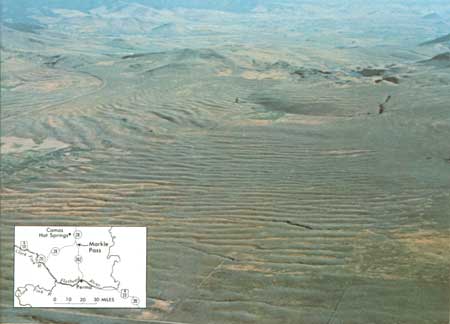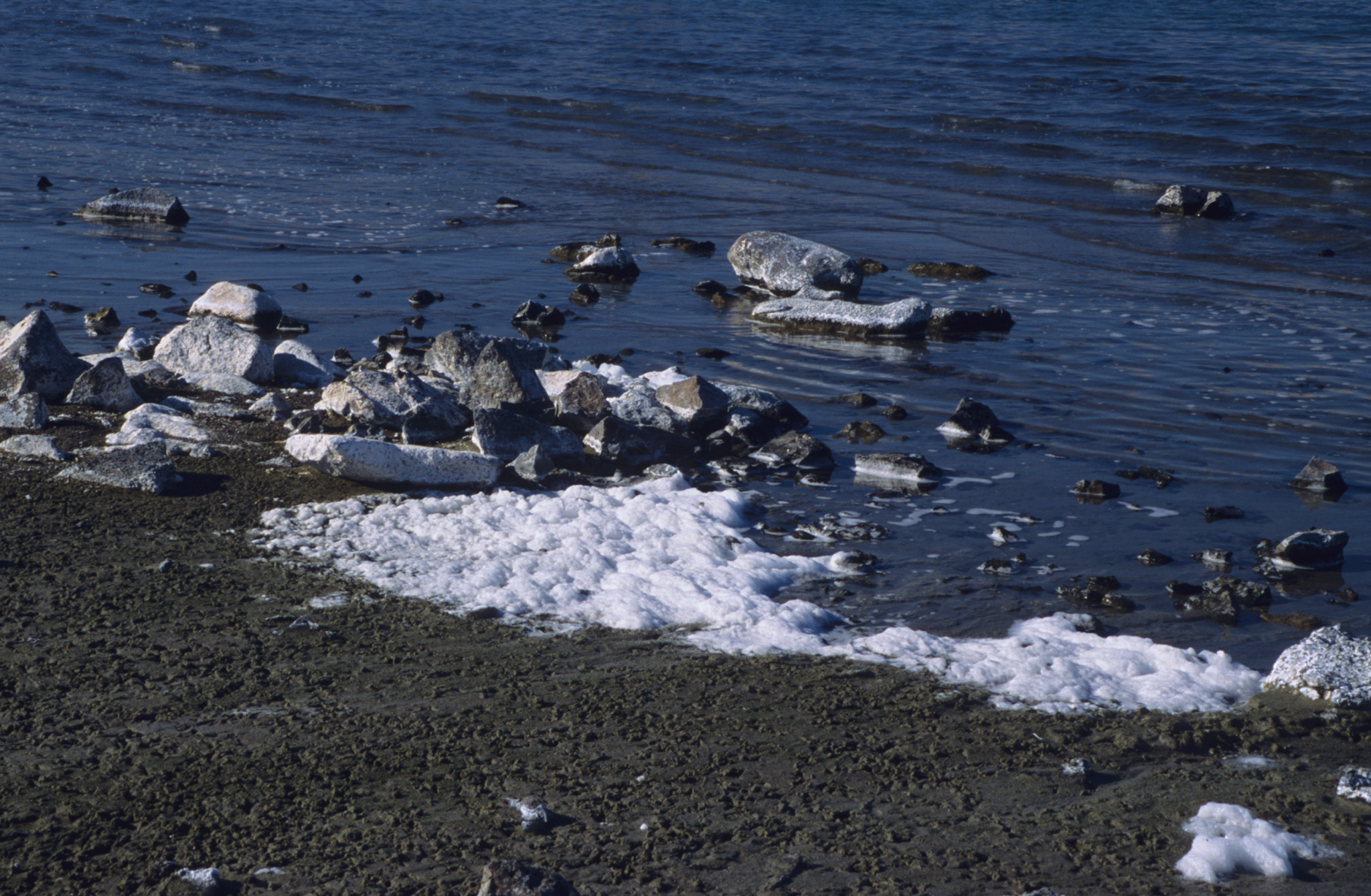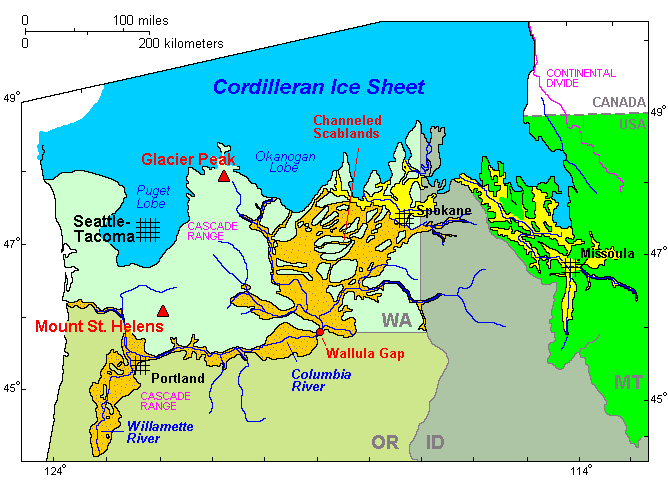|
Lake Lenore (Washington)
Lake Lenore, also known as Lenore Lake, is a lake in Grant County, Washington, United States. It is a 1,670-acre (680 ha) lake formed by the Missoula Floods in the lower Coulee just north of the town of Soap Lake, Washington. It is situated between Alkali Lake to the north and Soap Lake to the south. The lake is rather narrow, but long. The length of the lake runs north–south alongside State Route 17 leading from near the city of Soap Lake to Coulee City. Lenore Canyon is a coulee associated with the development of the Scablands. One of the interesting areas around Lake Lenore is the Lenore Caves. Located at the northern end of the lake, the Lenore Caves are a series of overhangs along the cliffs at the lake. They exist in one of the largest volcanic regions on Earth. Lenore Caves The Lenore Caves were formed by the plucking of basalt from the walls of the coulees by the Missoula floods and are geologically different from most caverns. They were later used as shelters ... [...More Info...] [...Related Items...] OR: [Wikipedia] [Google] [Baidu] |
Washington State Route 17
State Route 17 (SR 17) is a state highway serving the Columbia Plateau in the central region of the U.S. state of Washington. The highway travels through mostly rural areas of Franklin. Adams, Grant, Douglas, and Okanogan counties and is designated as part of the National Highway System between Mesa and Moses Lake and as the Coulee Corridor Scenic Byway between Othello and Coulee City for passing through the Grand Coulee. SR 17 begins in Mesa at an interchange with U.S. Route 395 (US 395) and travels north and intersects SR 26 near Othello before entering Moses Lake, where the highway intersects Interstate 90 (I-90) and travels as a partial expressway. SR 17 continues north, intersecting SR 28 in Soap Lake, through the Grand Coulee to a short concurrency with US 2 west of Coulee City. The highway turns northwest and crosses the Columbia River on the Columbia River Bridge at Bridgeport before ending at US 97 in Br ... [...More Info...] [...Related Items...] OR: [Wikipedia] [Google] [Baidu] |
Grant County, Washington
Grant County is a county located in the U.S. state of Washington. As of the 2020 census, the population was 99,123. The county seat is Ephrata, and the largest city is Moses Lake. The county was formed out of Douglas County in February 1909 and is named for U.S. President Ulysses S. Grant. Grant County comprises the Moses Lake, WA Micropolitan Statistical Area, which is also part of the Moses Lake-Othello, WA Combined Statistical Area. History Native American cultures in the area included the Interior Salish, Wenatchi, and Okanagan. The first white settlers began to arrive in the mid-to-late-19th century, primarily with the goal of raising livestock. One government official described the area in 1879 as, "…a desolation where even the most hopeful can find nothing in its future prospects to cheer." When railroads arrived they also brought new settlers, and the economy began a shift from ranching to dryland farming. This transition required the people to have ready a ... [...More Info...] [...Related Items...] OR: [Wikipedia] [Google] [Baidu] |
Missoula Floods
The Missoula floods (also known as the Spokane floods or the Bretz floods or Bretz's floods) were cataclysmic glacial lake outburst floods that swept periodically across eastern Washington and down the Columbia River Gorge at the end of the last ice age. These floods were the result of periodic sudden ruptures of the ice dam on the Clark Fork River that created Glacial Lake Missoula. After each ice dam rupture, the waters of the lake would rush down the Clark Fork and the Columbia River, flooding much of eastern Washington and the Willamette Valley in western Oregon. After the lake drained, the ice would reform, creating Glacial Lake Missoula again. These floods have been researched since the 1920s. During the last deglaciation that followed the end of the Last Glacial Maximum, geologists estimate that a cycle of flooding and reformation of the lake lasted an average of 55 years and that the floods occurred several times over the 2,000-year period between 15,000 and 13,000 year ... [...More Info...] [...Related Items...] OR: [Wikipedia] [Google] [Baidu] |
Coulee
Coulee, or coulée ( or ) is a term applied rather loosely to different landforms, all of which refer to a kind of valley or drainage zone. The word ''coulee'' comes from the Canadian French ''coulée'', from French ''couler'' 'to flow'. The term is often used interchangeably in the Great Plains for any number of water features, from ponds to creeks. In southern Louisiana the word ''coulée'' (also spelled ''coolie'') originally meant a gully or ravine usually dry or intermittent but becoming sizable during rainy weather. As stream channels were dredged or canalized, the term was increasingly applied to perennial streams, generally smaller than bayous. The term is also used for small ditches or canals in the swamp. In the northwestern United States, coulee is defined as a large, steep-walled, trench-like trough, which also include spillways and flood channels incised into the basalt plateau. Types and examples * The dry, braided channels formed by glacial drainage of th ... [...More Info...] [...Related Items...] OR: [Wikipedia] [Google] [Baidu] |
Soap Lake, Washington
Soap Lake is a city in Grant County, Washington, on the shores of Soap Lake. The population was 1,691 at the 2020 census. History Soap Lake was officially incorporated on June 9, 1919. This came to a halt during the Depression when drought hit Soap Lake. Because of the lack of water and money, the tourist trade dwindled. But, when Grand Coulee Dam was built, the irrigation canals brought new life into the area. Soap Lake has been internationally known during the past century for its uniquely mineral-rich (23) waters and mud. Many people believe the water and mud to be successful in treatment of a variety of ailments. From the early 1900s to the mid-1940s, there were a number of sanitariums located on Soap Lake. These early versions of spas were used by visitors from all over the country and the world. When the sanitariums, hotels, and bath houses were full, people slept in tents, and even under their cars, in order to use the water of the lake. In 1933, the Veteran's Adminis ... [...More Info...] [...Related Items...] OR: [Wikipedia] [Google] [Baidu] |
Soap Lake
Soap Lake is a meromictic soda lake in the town of Soap Lake, Washington formed by the Missoula Floods at the foot of the Grand Coulee. The lake gets its name from the naturally occurring foam that gives its water a soapy appearance, and because the lake's mineral-rich waters have a slick, soapy feel. The lake is approximately in area and deep. Qualities Soap Lake's mineral-rich waters have long been thought to have medicinal value. In fact, it is said that rival native tribes would call a truce when they came to Soap Lake to relax and heal themselves and their animals. This is verified by recorded history and the number of Native American artifacts found in the area over the years. Washington State tourist guides in the 1920s referred to Soap Lake as the "world's greatest mineral sea" and people afflicted with Buerger's disease said that bathing in the lake cured their illness. The city of Soap Lake bills itself as "Washington's Health Resort". There are 23 different minera ... [...More Info...] [...Related Items...] OR: [Wikipedia] [Google] [Baidu] |
Coulee City, Washington
Coulee City is a town in Grant County, Washington, Grant County, Washington (state), Washington. The population was 549 at the 2020 United States census, 2020 census. History The town was named after nearby Grand Coulee. Coulee City was officially incorporated on May 10, 1907. Geography Coulee City is located at (47.611942, -119.290904). It sits on the southern shore of Banks Lake, a man-made reservoir that stretches for 27 miles to Grand Coulee Dam. At Coulee City, water from the reservoir enters a system of irrigation canals taking it to Billy Clapp Lake to the south and then beyond across the broader Columbia Basin Project. Dry Falls, site of a catastrophic and large prehistoric waterfall, is located about two miles southwest of Coulee City. U.S. Route 2 in Washington, U.S. Route 2 passes through the town from west to east and intersects Washington State Route 17, State Route 17, which provides north-south connections. Washington State Route 155, State Route 155 has its so ... [...More Info...] [...Related Items...] OR: [Wikipedia] [Google] [Baidu] |
Coulee
Coulee, or coulée ( or ) is a term applied rather loosely to different landforms, all of which refer to a kind of valley or drainage zone. The word ''coulee'' comes from the Canadian French ''coulée'', from French ''couler'' 'to flow'. The term is often used interchangeably in the Great Plains for any number of water features, from ponds to creeks. In southern Louisiana the word ''coulée'' (also spelled ''coolie'') originally meant a gully or ravine usually dry or intermittent but becoming sizable during rainy weather. As stream channels were dredged or canalized, the term was increasingly applied to perennial streams, generally smaller than bayous. The term is also used for small ditches or canals in the swamp. In the northwestern United States, coulee is defined as a large, steep-walled, trench-like trough, which also include spillways and flood channels incised into the basalt plateau. Types and examples * The dry, braided channels formed by glacial drainage of th ... [...More Info...] [...Related Items...] OR: [Wikipedia] [Google] [Baidu] |
Scablands
The Channeled Scablands are a relatively barren and soil-free region of interconnected relict and dry flood channels, coulees and cataracts eroded into Palouse loess and the typically flat-lying basalt flows that remain after cataclysmic floods within the southeastern part of Washington.Neuendorf, K.K.E., J.P. Mehl, Jr., and J.A. Jackson, eds. (2005) ''Glossary of Geology'' (5th ed.). Alexandria, Virginia, American Geological Institute. 779 pp. The Channeled Scablands were scoured by more than 40 cataclysmic floods during the Last Glacial Maximum and innumerable older cataclysmic floods over the last two million years. These floods were periodically unleashed whenever a large glacial lake broke through its ice dam and swept across eastern Washington and down the Columbia River Plateau during the Pleistocene epoch. The last of the cataclysmic floods occurred between 18,200 and 14,000 years ago.Balbas, A.M., Barth, A.M., Clark, P.U., Clark, J., Caffee, M., O'Connor, J., Baker, V.R ... [...More Info...] [...Related Items...] OR: [Wikipedia] [Google] [Baidu] |
Missoula Floods
The Missoula floods (also known as the Spokane floods or the Bretz floods or Bretz's floods) were cataclysmic glacial lake outburst floods that swept periodically across eastern Washington and down the Columbia River Gorge at the end of the last ice age. These floods were the result of periodic sudden ruptures of the ice dam on the Clark Fork River that created Glacial Lake Missoula. After each ice dam rupture, the waters of the lake would rush down the Clark Fork and the Columbia River, flooding much of eastern Washington and the Willamette Valley in western Oregon. After the lake drained, the ice would reform, creating Glacial Lake Missoula again. These floods have been researched since the 1920s. During the last deglaciation that followed the end of the Last Glacial Maximum, geologists estimate that a cycle of flooding and reformation of the lake lasted an average of 55 years and that the floods occurred several times over the 2,000-year period between 15,000 and 13,000 year ... [...More Info...] [...Related Items...] OR: [Wikipedia] [Google] [Baidu] |
War Assets Administration
The War Assets Administration (WAA) was created to dispose of United States government-owned surplus material and property from World War II. The WAA was established in the Office for Emergency Management, effective March 25, 1946, by Executive Order 9689, January 31, 1946. It was headed by Robert McGowan Littlejohn. Predecessor agencies * Petroleum Reserves Corporation (PRC), Reconstruction Finance Corporation (RFC, June–July 1943) * PRC, Office of Economic Warfare (OEW, July–September 1943) * PRC, Foreign Economic Administration (FEA, September 1943-September 1945) * PRC, RFC (September–November 1945) * War Assets Corporation (WAC), RFC (November 1945-March 1946) * Surplus War Property Administration (SWPA), Office of War Mobilization (OWM, February–October 1944) * Surplus Property Board (SPB), Office of War Mobilization and Reconversion (OWMR, October 1944-September 1945) * Surplus Property Administration (SPA), OWMR (September 1945-March 1946) Functions The WA ... [...More Info...] [...Related Items...] OR: [Wikipedia] [Google] [Baidu] |
Sodium
Sodium is a chemical element with the symbol Na (from Latin ''natrium'') and atomic number 11. It is a soft, silvery-white, highly reactive metal. Sodium is an alkali metal, being in group 1 of the periodic table. Its only stable isotope is 23Na. The free metal does not occur in nature, and must be prepared from compounds. Sodium is the sixth most abundant element in the Earth's crust and exists in numerous minerals such as feldspars, sodalite, and halite (NaCl). Many salts of sodium are highly water-soluble: sodium ions have been leached by the action of water from the Earth's minerals over eons, and thus sodium and chlorine are the most common dissolved elements by weight in the oceans. Sodium was first isolated by Humphry Davy in 1807 by the electrolysis of sodium hydroxide. Among many other useful sodium compounds, sodium hydroxide (lye) is used in soap manufacture, and sodium chloride (edible salt) is a de-icing agent and a nutrient for animals inc ... [...More Info...] [...Related Items...] OR: [Wikipedia] [Google] [Baidu] |






